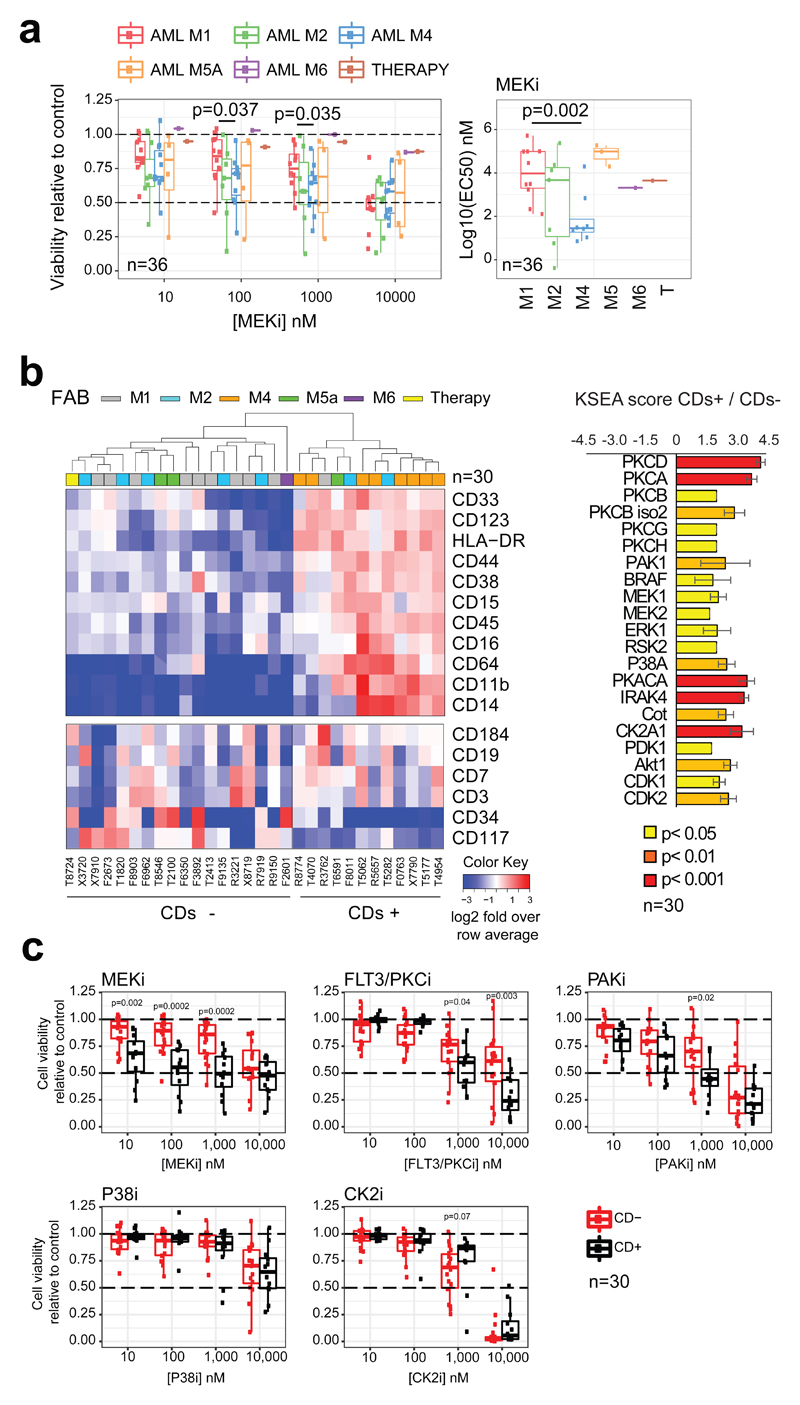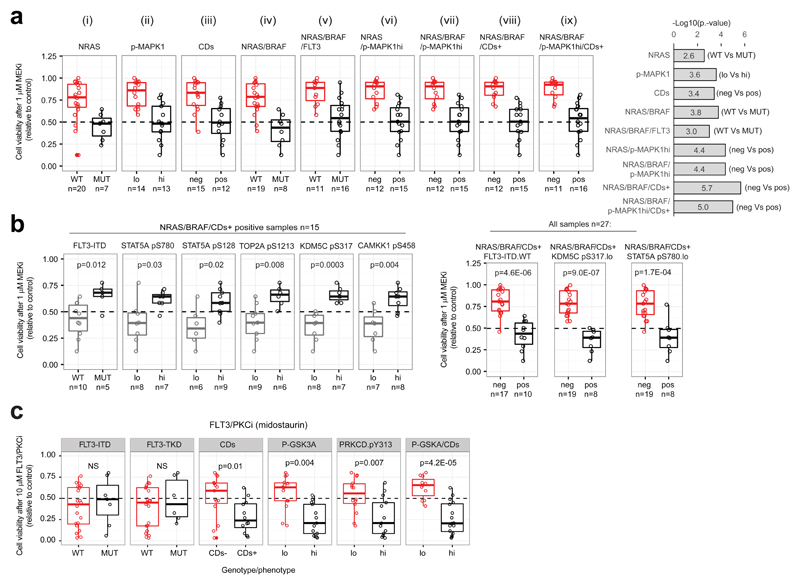Kinase inhibitors are efficient in reducing cancer cell viability in cases where malignant cells present a dependency or addiction to the targeted kinase1. Genetic alterations can cause constitutive activation of pro-survival and proliferative pathways and often determine the extent by which cancer cells respond to targeted drugs2, 3. However, other biochemical events, not directly linked to genetic mutations may also contribute to the modulation of oncogenic kinase activity and thus influence responses to kinase targeted drugs 4, 5. Here, we integrated drug sensitivity, proteomic, phosphoproteomic, immunophenotypic and genomic analyses of primary AML to rationalize responses and identify determinants of sensitivity of AML cells to targeted compounds of clinical and preclinical interest in this disease.
We investigated the effects on cell viability of inhibitors for the kinases FLT3/PKC (midostaurin), PAK (PF-3758309), CK2 (silmitasertib), MEK (trametinib) and P38 (TAK-715). Hereafter named as FLT3/PKCi, PAKi, CK2i, MEKi, and P38i, respectively. Dose response curves for cells obtained from 36 AML patients (Data File S1) showed heterogeneous responses to all compounds (Figure S1). However, samples of the M4 FAB subtype were on average more sensitive than M1 samples to MEKi (figure 1a).
Figure 1. Association of differentiation, kinase activity and sensitivity to kinase inhibitors in primary AML.
(a) Sensitivity to MEKi as a function of FAB group. (b) CD expression across 30 cases and estimation of individual kinase activities in CDs+ and CDs- groups. (c) Sensitivity to kinase inhibitors as a function of CD pattern expression. Significance was assessed by Mann-Whitney test in (a, c) and with a z-test in (b).
Based on the surface expression of a set of co-expressed CD markers (figure S2a), mass cytometry data subdivided our patient samples into two groups (figure 1b (heat-map)). These analyses could be performed in 30 cases with sufficient number of cells and produced two main groups, which we termed CDs+ and CDs-, consisting of 12 and 18 patients, respectively. Untargeted mass spectrometry proteomics (Data File S2) uncovered greater expression in the CDs+ group relative to CDs- of a set of proteins linked to differentiation, several kinases and other signal-transduction regulators (figure S2b-c). Global phosphoproteomics by mass spectrometry showed that CDs+ cells had an increase in protein phosphorylation relative to the CDs- cases (figure S2d, Data File S3) and activated kinases downstream growth factor signaling, as illustrated by Kinase Substrate Enrichment Analysis6 (KSEA, figure 1b (bar-plot)). In addition, individual phosphorylation markers7 on ERK1/2 (MAPK3/1), PAK1/2, MEK1 (MAP2K1), and PKCδ (PRKCD) were highly phosphorylated in the CDs+ group (figure S2d) and correlated with the surface expression of individual CD markers linked to differentiation (figure S3a and S3b).
Since CDs+ cases activated kinase survival pathways to a greater extent than CDs- cases, we reasoned that cells from these groups would respond differently to kinase inhibitors. Consistently with this hypothesis, cell viability analysis as a function of treatment with kinase inhibitors showed that CDs+ cases were more sensitive than CDs- to MEKi (at 10, 100 and 1,000nM), FLT3/PKCi (1 and 10μM) and PAKi (1μM) (figure 1c). These concentrations are physiologically relevant for MEKi and FLT3/PKCi8, 9. Together, our results suggest that CDs+ cells had higher expression of proteins associated with myelomonocytic differentiation and kinase-signaling relative to negative cells, and consequently showed high phosphorylation and activation of pro-survival kinases, which was translated into an increased sensitivity to treatments with PAKi, midostaurin and trametinib.
In order to rationalize drug responses with greater detail, we sequenced 25 genes frequently mutated in AML in 27 cases of our cohort (Data File S4, sequencing failed in 3 samples). We found that genes involved in kinase-signaling (NRAS, BRAF and FLT3), were more frequently mutated in CDs+ cases (figure S4, p=0.008 by hypergeometric test). We performed an integrative and systematic analysis of mutational profiles with the mass spectrometry and cytometry data. Cells positive for NRAS mutations, high MAPK1 phosphorylation or the CDs+ phenotype were more sensitive to MEKi than negative cells (figure 2a (i-iv)). Cells with the NRAS/BRAF/FLT3-ITD genotypes were not more sensitive to MEKi than cells with just either NRAS or BRAF mutations (figure 2a (v)). In contrast, cases positive for NRAS, BRAF mutations or the CDs+ phenotype (NRAS/BRAF/CDs+) were on average more sensitive to MEKi than cells without this molecular signature (figure 2a (vi-ix)). The p-value assessment for the comparisons showed that the NRAS/BRAF/CDs+ signature produced the most significant difference followed by the NRAS/BRAF/p-MAPK1hi/CDs+ signature (figure 2 (bar-plot)). Our results suggest that, in addition to NRAS/BRAF activating mutations, the RAS/MEK/ERK pathway may be activated by other means in cells with high expression of CD markers. Thus, MEKi treatment was more likely to reduce AML cell viability in cases positive for at least one of these markers (NRAS/BRAF mutations or specific CD pattern expression).
Figure 2. Integration of genomic, phosphoproteomics and mass cytometry data to rationalize kinase inhibitors sensitivity.
(a) Viability of AML cells within the indicated genotype/phenotype groups after treatment with MEKi. (b) Sensitivity of NRAS/BRAF/CDs+ positive cells to MEKi as a function of the indicated factors. (c) FLT3/PKCi sensitivity of AML cells with the indicated phenotype/genotype. Phosphorylations are denoted as (hi) and (lo) based on a greater or lower phosphorylation than the median across all cases. Significance was assessed by Mann-Whitney test.
Although 15 cases with the NRAS/BRAF/CDs+ signature were on average more sensitive to MEKi than negative cases, 8 of such cases were resistant (viability>50%) to treatment (figure 2a (viii)). Within these 15 cases positive for NRAS/BRAF/CDs+, cells with FLT3-ITD mutations were significantly more resistant to MEKi than cells without this mutation (p=0.012, figure 2b). Several phosphorylation markers were also found to be associated with responses to MEKi within the NRAS/BRAF/CDs+ cases, including STAT5AS780, STAT5AS128, TOP2AS1213, KDM5CS317 and CAMKK1S458 (figure 2b). When the whole cohort of 27 patients was considered, samples positive for NRAS/BRAF/CDs+ and negative for FLT3-ITD or low pSTAT5A or pKDM5C were more sensitive to MEKi than the other cells (figure 2d, figure S5a). This higher sensitivity of NRAS/BRAF/CDs+ cases that were FLT3-ITD negative or pKDM5C S317 low was consistent across several MEKi concentrations (figure S5a).
Our results suggest two distinct mechanisms of intrinsic resistance to MEK inhibition. One occurs in cells that are not addicted to the pro-survival actions of MEK because these have low RAS/MEK/ERK pathway activity. The other occurs in cells which, albeit having a highly active RAS/MEK/ERK, bypass MEK inhibition using the FLT3/STAT5 axis; a pathway known to sustain AML viability and proliferation by acting in parallel to RAS/MEK/ERK signaling10, 11. Pemovska et al. also observed a high response to trametinib in a subgroup of AML primary cells12. NRAS is frequently mutated in AML and in a recent clinical trial ~ 20% of AML patients positive for NRAS or KRAS mutations responded to trametinib 13. Our results suggest that selection of patients for therapy based not only on NRAS/KRAS mutations but also on direct markers of MEK activity, and STAT5 and KDM5A phosphorylation may increase the proportion of patients that will respond to this treatment.
We also noted that FLT3-ITD status was not associated with the responses of cells to FLT3/PKCi (figure 2c, figure S5b), an inhibitor recently approved to treat FLT3 mutant AML [ref14]. In contrast, CD expression and phosphorylation markers on PKCδ and on its substrate GSK3A [Ref 15] were increased in FLT3/PKCi sensitive cells at 10μM and 1μM (figure 2c, figure S5b). Our results suggest that the mode of action of midostaurin may involve the inhibition of PKCδ (a known target of this drug) which we found activated in primary AML (figure 1b, figure S4a).
In conclusion, we found that AML cells remodel their kinase-signaling network during differentiation, resulting in a marked increase in the activity of pro-survival pathways regulated by MEK and PKC. Specific combinations of target and parallel kinase-pathway activation (caused by genetic and non-genetic events) determined the extent by which AML cells respond to treatments with trametinib or midostaurin.
Supplementary Material
“Supplementary information available at Leukemia’s website”
Acknowledgments
We thank Steve Lim, Marilyn Salvat-Lago and Lara Painter for technical support, Janet Mathews for clinical data and Maruan Hijazi for manuscript reading.
Funding: Barts and The London Charity (297/2249), CRUK (C16420/A18066) and BBSRC (BB/M006174/1).
Footnotes
Conflict of interests: The authors declare no conflict of interests.
References
- 1.Workman P, Al-Lazikani B, Clarke PA. Genome-based cancer therapeutics: targets, kinase drug resistance and future strategies for precision oncology. Curr Opin Pharmacol. 2013 Aug;13(4):486–496. doi: 10.1016/j.coph.2013.06.004. [DOI] [PubMed] [Google Scholar]
- 2.Papaemmanuil E, Gerstung M, Bullinger L, Gaidzik VI, Paschka P, Roberts ND, et al. Genomic Classification and Prognosis in Acute Myeloid Leukemia. N Engl J Med. 2016 Jun 9;374(23):2209–2221. doi: 10.1056/NEJMoa1516192. [DOI] [PMC free article] [PubMed] [Google Scholar]
- 3.Cancer Genome Atlas Research N. Genomic and epigenomic landscapes of adult de novo acute myeloid leukemia. N Engl J Med. 2013 May 30;368(22):2059–2074. doi: 10.1056/NEJMoa1301689. [DOI] [PMC free article] [PubMed] [Google Scholar]
- 4.Lemmon MA, Schlessinger J. Cell signaling by receptor tyrosine kinases. Cell. 2010 Jun 25;141(7):1117–1134. doi: 10.1016/j.cell.2010.06.011. [DOI] [PMC free article] [PubMed] [Google Scholar]
- 5.Straussman R, Morikawa T, Shee K, Barzily-Rokni M, Qian ZR, Du J, et al. Tumour micro-environment elicits innate resistance to RAF inhibitors through HGF secretion. Nature. 2012 Jul 26;487(7408):500–504. doi: 10.1038/nature11183. [DOI] [PMC free article] [PubMed] [Google Scholar]
- 6.Casado P, Rodriguez-Prados JC, Cosulich SC, Guichard S, Vanhaesebroeck B, Joel S, et al. Kinase-substrate enrichment analysis provides insights into the heterogeneity of signaling pathway activation in leukemia cells. Sci Signal. 2013 Mar 26;6(268):rs6. doi: 10.1126/scisignal.2003573. [DOI] [PubMed] [Google Scholar]
- 7.Wilkes EH, Terfve C, Gribben JG, Saez-Rodriguez J, Cutillas PR. Empirical inference of circuitry and plasticity in a kinase signaling network. Proc Natl Acad Sci U S A. 2015 Jun 23;112(25):7719–7724. doi: 10.1073/pnas.1423344112. [DOI] [PMC free article] [PubMed] [Google Scholar]
- 8.Wang Y, Yin OQ, Graf P, Kisicki JC, Schran H. Dose- and time-dependent pharmacokinetics of midostaurin in patients with diabetes mellitus. J Clin Pharmacol. 2008 Jun;48(6):763–775. doi: 10.1177/0091270008318006. [DOI] [PubMed] [Google Scholar]
- 9.Leonowens C, Pendry C, Bauman J, Young GC, Ho M, Henriquez F, et al. Concomitant oral and intravenous pharmacokinetics of trametinib, a MEK inhibitor, in subjects with solid tumours. Br J Clin Pharmacol. 2014 Sep;78(3):524–532. doi: 10.1111/bcp.12373. [DOI] [PMC free article] [PubMed] [Google Scholar]
- 10.Mizuki M, Fenski R, Halfter H, Matsumura I, Schmidt R, Muller C, et al. Flt3 mutations from patients with acute myeloid leukemia induce transformation of 32D cells mediated by the Ras and STAT5 pathways. Blood. 2000 Dec 01;96(12):3907–3914. [PubMed] [Google Scholar]
- 11.Hayakawa F, Towatari M, Kiyoi H, Tanimoto M, Kitamura T, Saito H, et al. Tandem-duplicated Flt3 constitutively activates STAT5 and MAP kinase and introduces autonomous cell growth in IL-3-dependent cell lines. Oncogene. 2000 Feb 03;19(5):624–631. doi: 10.1038/sj.onc.1203354. [DOI] [PubMed] [Google Scholar]
- 12.Pemovska T, Kontro M, Yadav B, Edgren H, Eldfors S, Szwajda A, et al. Individualized systems medicine strategy to tailor treatments for patients with chemorefractory acute myeloid leukemia. Cancer Discov. 2013 Dec;3(12):1416–1429. doi: 10.1158/2159-8290.CD-13-0350. [DOI] [PubMed] [Google Scholar]
- 13.Borthakur G, Popplewell L, Boyiadzis M, Foran J, Platzbecker U, Vey N, et al. Activity of the oral mitogen-activated protein kinase kinase inhibitor trametinib in RAS-mutant relapsed or refractory myeloid malignancies. Cancer. 2016 Jun 15;122(12):1871–1879. doi: 10.1002/cncr.29986. [DOI] [PMC free article] [PubMed] [Google Scholar]
- 14.Stone RM, Mandrekar SJ, Sanford BL, Laumann K, Geyer S, Bloomfield CD, et al. Midostaurin plus Chemotherapy for Acute Myeloid Leukemia with a FLT3 Mutation. The New England journal of medicine. 2017 Aug 03;377(5):454–464. doi: 10.1056/NEJMoa1614359. [DOI] [PMC free article] [PubMed] [Google Scholar]
- 15.Fang X, Yu S, Tanyi JL, Lu Y, Woodgett JR, Mills GB. Convergence of multiple signaling cascades at glycogen synthase kinase 3: Edg receptor-mediated phosphorylation and inactivation by lysophosphatidic acid through a protein kinase C-dependent intracellular pathway. Molecular and cellular biology. 2002 Apr;22(7):2099–2110. doi: 10.1128/MCB.22.7.2099-2110.2002. [DOI] [PMC free article] [PubMed] [Google Scholar]
Associated Data
This section collects any data citations, data availability statements, or supplementary materials included in this article.




